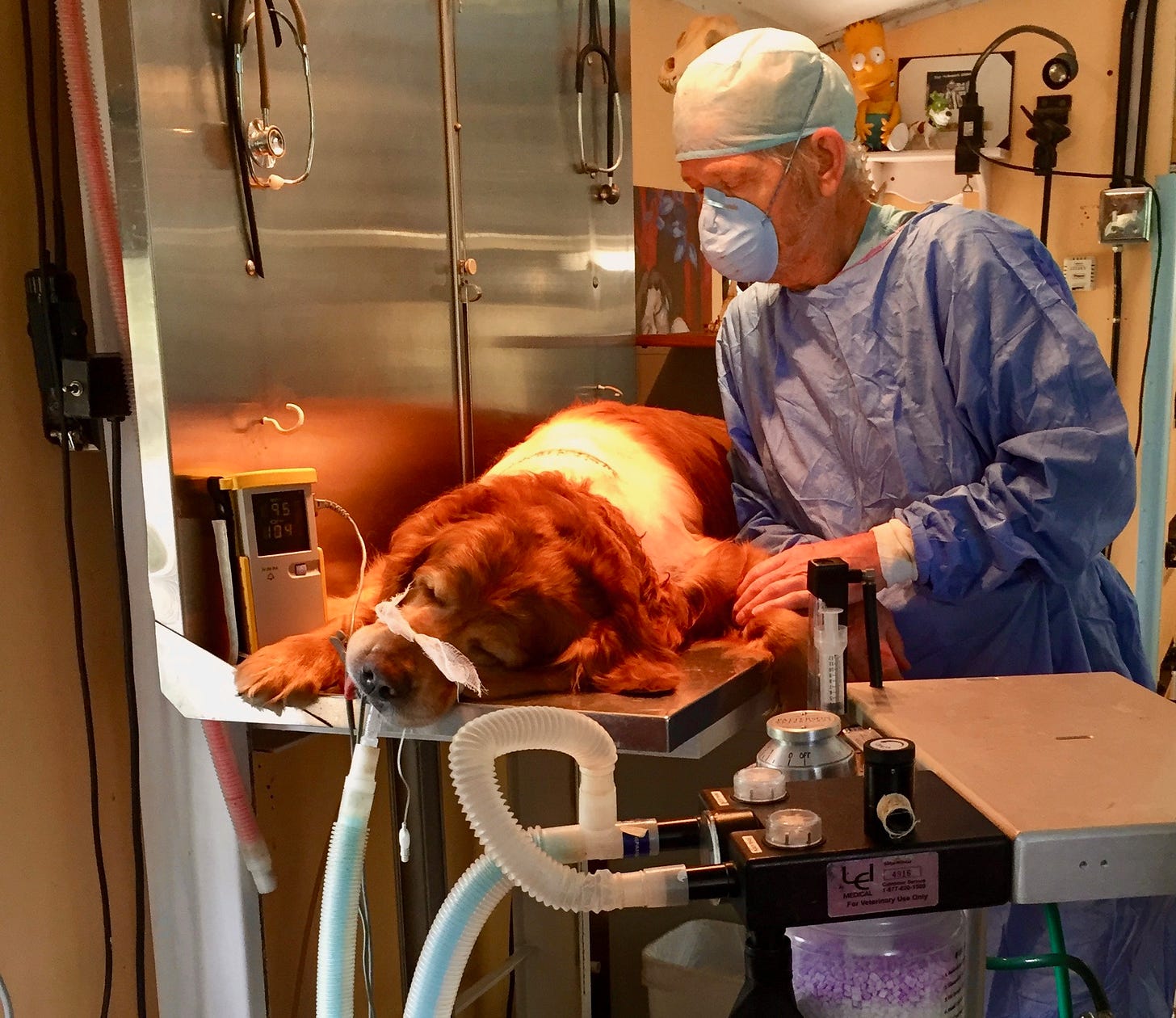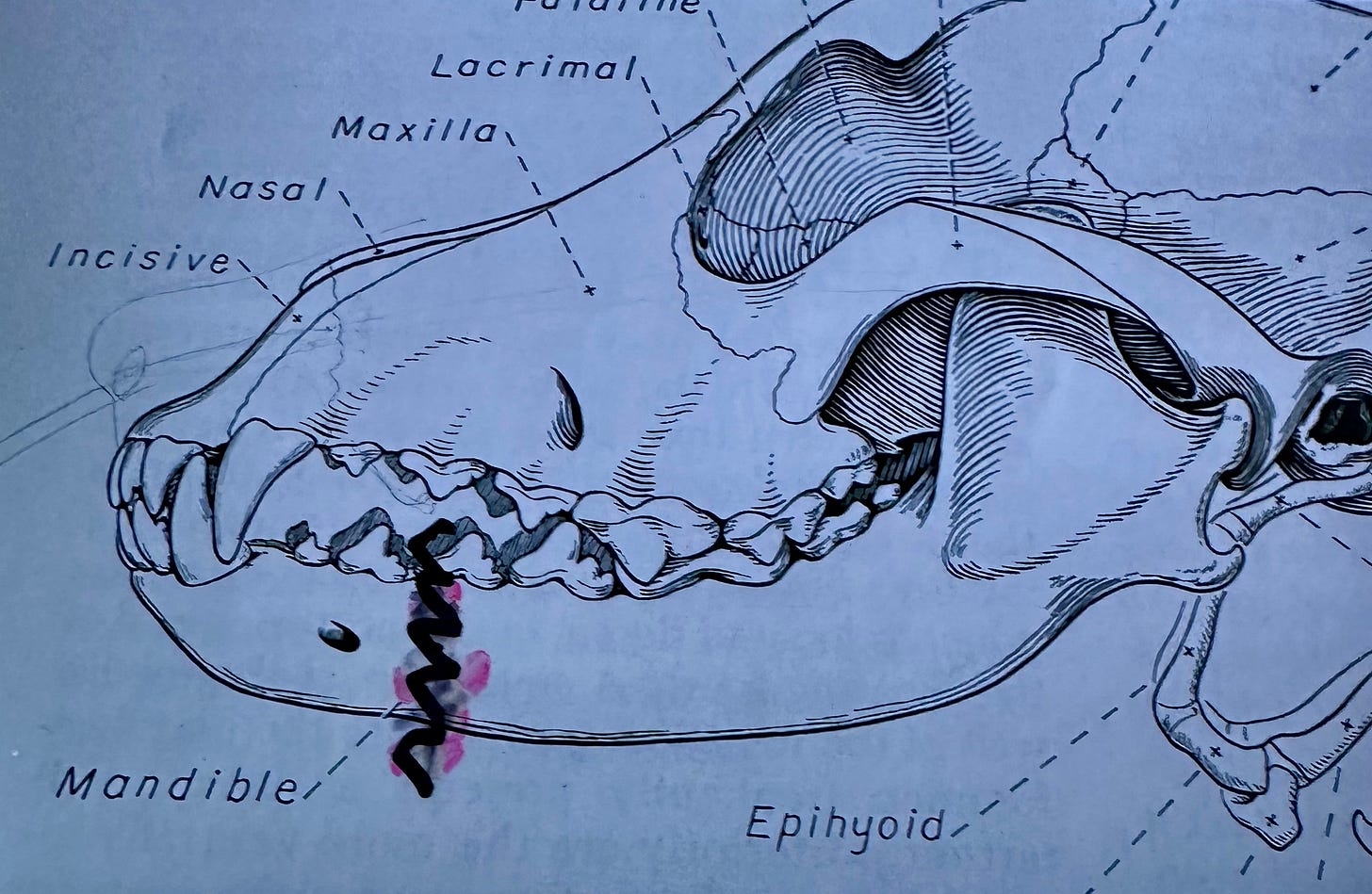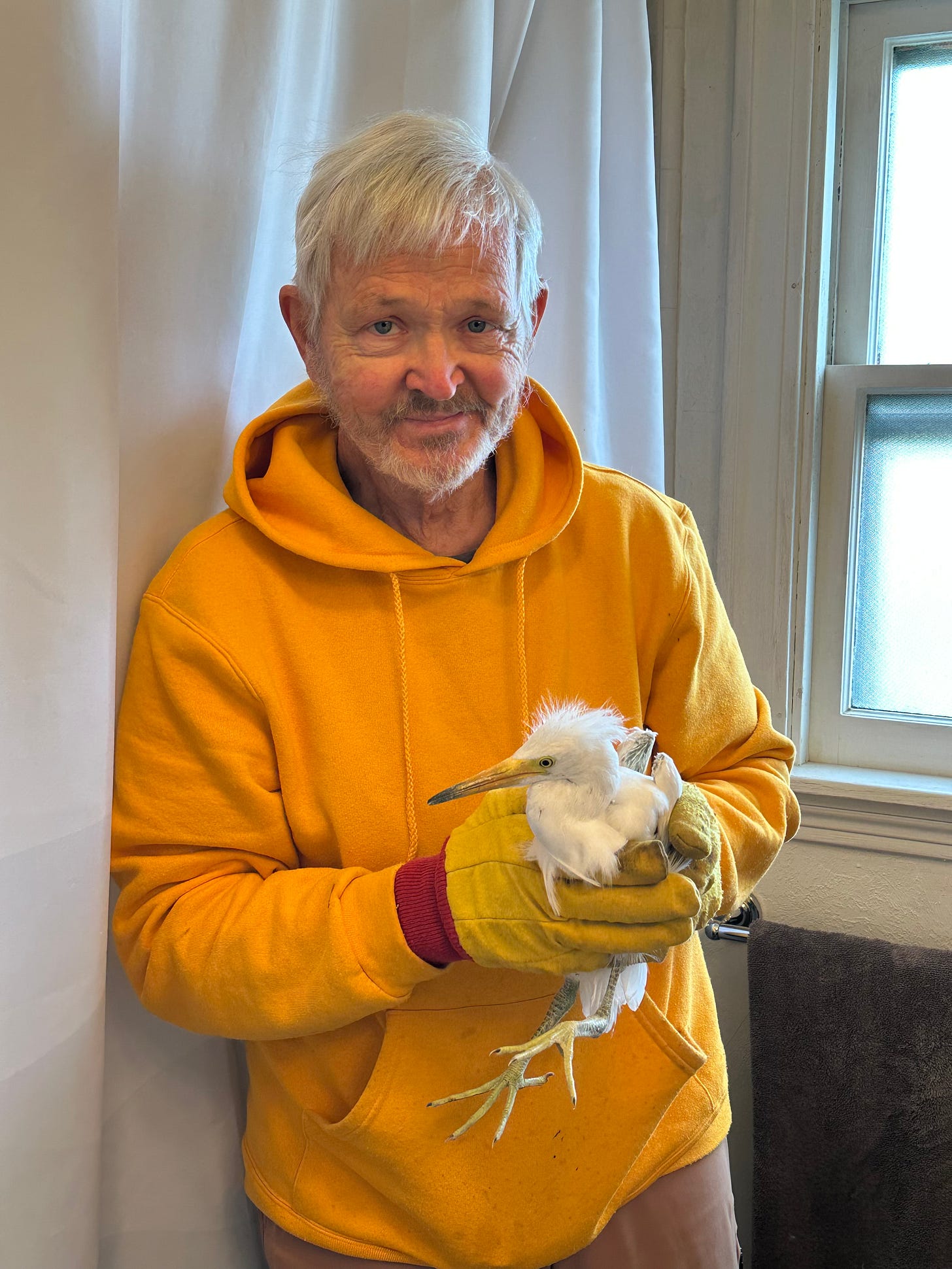The End of April
A West County veterinarian warns about the rise of corporations providing veterinary care
by Peter Henriksen, DVM
I have been a small animal veterinarian for over 50 years. As a science/biology fan and an animal enthusiast, this was an obvious career choice for me. I eventually ran my own veterinary clinic. People of all sizes and shapes brought their broken pets to me and I did my best to fix them. Some of those patients died but never from lack of money to put them back together.
I’m going to tell you a story about a family who brought their dog, April, to me. What happened to April and this family illustrates a much larger story of how veterinary medicine has changed since I became a practicing vet, and not for the better.
1.
One day, at the small door of my clinic came, a new client arrived accompanied by her family of three. There was a soft spoken, single mother in her late thirties. Following her came Eva, a nervous, very quiet middle school girl clutching the patient, April, close to her chest. Bringing up the rear was a slender shy young boy doing his best to remain invisible.
The four of us crowded around the exam table to look at April. Eva hesitantly set her down. Staring back at me was an older dog who had been in poor health for over a year. It wasn’t difficult for me to tell where April’s main problem was. Her halitosis had overtaken the small exam room within minutes of her entry. She was a good-natured animal but drew the line at allowing me to look into her mouth.
I suggested the family leave her with me for the afternoon, giving me time to sedate her, get a good oral exam and contact the previous clinic for some history. I’ll not soon forget the look on Eva’s face and her body language as she inched her way to the car. As it turned out, that was the last time Eva and April would see each other, after growing up together in the same house for the past 12 years.
After sedation, what I saw in April’s mouth was truly appalling. The teeth were tartar laden and surrounded by gingivitis and gum recession. Many were loose and on the verge of falling out on their own. None of this was particularly unusual for an elderly small-breed dog whose owner was struggling to feed the family and pay the rent. Nowhere in the budget was $1,200 for a dog dentist.
What was conspicuously out of the ordinary was the broken lower jaw – not a new fracture. The bone was infected and the fragments were way out of line. That this happened and was not treated while under the routine care of a veterinarian, in my mind, is immoral and unethical. As things deteriorated in April’s mouth, chewing got more painful and the problem was more expensive to fix.
Previously, the mother had brought April several times to a local, corporate veterinary hospital run by Veterinary Centers of America (VCA). When I called the doctor of record at VCA, I was informed he had quit and left the State. The doctor taking his place chose not to speak with me. They did email April’s records to me. What I had heard from the family was all true. One thing VCA is good at is record keeping. They are just not good at treatment. That’s where the money puts a hold on many things that needed doing.
The records showed that VCA had seen April on several visits. She had multiple problems including an ulcer on one cornea, which was likely caused by rubbing her face on the ground and rug from tooth pain. A year later, the family had saved enough money to do a partial dental procedure. The upper jaw (maxilla) was treated since it appeared to be more seriously affected than the lower (mandible). It is a mystery why any veterinarian would give a dog general anesthesia, and all that accompanies it, and not do the complete dental procedure – unless the family could not afford it.
One last chapter in poor April’s medical history has her coming in after being attacked by a housemate. She had broken ribs and a fractured jaw. She was referred to another VCA specialty hospital to attempt repair of the jaw fracture. It was assumed the standard repair using wires would not work, based on the weak condition of the bone caused by chronic periodontal disease. It would require a hemimandibulectomy, a surgical removal of one side of the lower jaw. It is painful and messy and can require weeks to months of tube feeding and several thousand dollars in specialty fees.
How should April’s case have been handled? If the original quote for treatment was beyond the owners ability to pay up front, she should have been offered monthly payments. That combined with pro bono services from the veterinarian and a discount for a low income family should have solved the problem. General anesthesia, cleaning and appropriate extractions could have put April on the road to health again. Living with that mouth, especially for so long, had to have been a painful experience for April and her family.
I knew that even if April was a healthy patient with a strong jaw, fixing her problems would not have been easy. I spoke to the mother and told her if April were mine, I would let her go. All things considered, she had suffered enough. The family reluctantly agreed to euthanasia. I asked if they would like to drive out to say goodbye? The mother said “No. How would we be able to get back in the car and leave knowing we had just signed her death warrant? We can do our crying here at home.”

2.
I have done as many as hundreds of euthanasias in my time. People used to ask me “How can you kill peoples’ pets as a regular part of your job?” The truth is, for me, it’s not as bad as it seems. The animal is no longer suffering and the owner’s grief is buffered by relief that their pet’s pain and misery is over. They somehow gather the courage to allow it to be done and relief comes at least for a short time. At the end of the day, I feel grateful that I could be part of all that, doing my best to diminish the pain suffered by animal and owner.
It was vastly different with April. The euthanasias I did earlier needed to be done. Most people who really love their animals wait too long because they just can’t let go. April died before her time because the family didn’t have the money to care for her! A family member should not be killed because the family doesn’t have hundreds or thousands of dollars up front.
3.
I have watched the corporate takeover of veterinary medicine change the very nature of our business from individual practitioners to corporate clinics.
This is how it works. A veterinarian who has worked most of his/her life to build a practice decides he/she wants to sell and retire. The best offer he/she gets is from Veterinary Centers of America. VCA is a massive corporation owned by the Mars candy bar family, one of the richest families in the country. So far, VCA owns about 1,000 clinics and is growing fast, especially in my area. They are one of the most aggressive of the many corporate operations out there.
The only winner in the takeover of our profession is the corporation. It gets its money and lots of it. Pets and their owners lose unless they have plenty of money. Veterinarians lose. They spent at least eight years and a barrel of money to become vets and now they must turn away patients with a perfectly good prognosis because of money.
Once veterinarians become employees of VCA, they have no control over pricing. As fees for services rise, the veterinarians’ ability to make payment arrangements, give discounts or do pro bono work is eliminated.
That’s no way for smart and talented animal lovers to use their skills. Technicians lose. They are some of the nicest and most compassionate animal lovers on the planet. They are surrounded daily by this disaster in progress. Receptionists lose. The first people pet owners encounter when they enter a hospital are, some say, the most important of all to a hospital’s success. Now they get to give people quotes for procedures and take their money, and they must turn away those cannot pay for care.
Corporations don’t seem to realize that pets are a lot more than sources of revenue. The pet owners and those of us who look after their health enjoy their company and love having them in our lives.
Personally, even though it’s been several years since I saw April and her family, I am and will continue to hold a grudge when I think about the end of April. I don’t see April’s death as an accident. It is a consequence of the system of veterinary care that we now have. For now, all I can advise is that you avoid corporate clinics and hold your pets close.
Peter Henriksen, DVM, who lives in Occidental, graduated from Iowa State Veterinary College in 1972. He worked as a small animal practitioner for the next 50 years in Wisconsin, Minnesota, and finally California. He retired in 2020. He can be reached at phenriksendvm69@gmail.com.




Private equity firms are the single most dangerous organizations in the country. They are buying up every type of single owner services available for sale and doing exactly what happened here. These small businesses are the backbone of our economy and provide decent livings for their owners and employees. Plumbers, electricians, physical therapists, vets. Small hotels. Pretty soon no competition and the communities lose. If this continues there will be no place for small entrepreneurs in our economy. Everyone will be an employee of some rapacious, stingy corporation, and will be living from inadequate paycheck to inadequate paycheck.
This is a sad and important warning. While the focus of the article is on corporate ownership, underneath it is the story of what happens to an economy that concentrated all its wealth in the top 1%. We have been captured by the illusion of trickle down economics and are now being tied down by the whims and impulses of mega billionaires. Frequently we think of these folks as the tech elite—Musk, Bezons, Zuckerberg—but it goes far beyond that. It is the nameless corporation US Storage that bought out Sebastopol’s Southpoint storage, it is the reckless consolidation of the drug store industry, it is the handful of companies that decided what most of us eat. Thank you for the advice Dr. Henriksen. It applies to vets and so many others.